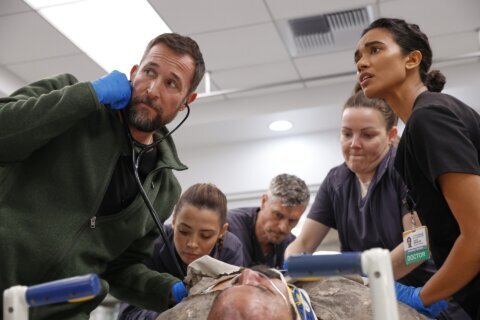You might not expect a talky drama about two popes at the Vatican to be engaging.
But that’s exactly what filmmaker Fernando Meirelles pulls off in “The Two Popes,” thanks to a pair of superb performances by Anthony Hopkins as Pope Benedict and Jonathan Pryce as successor Pope Francis; both sure to get a look come Oscar time.
Set in 2012, Cardinal Jorge Mario Bergoglio (Pryce) flies from Argentina to Rome to ask Pope Benedict (Hopkins) his permission to retire. While the conservative pope and progressive cardinal initially clash due to contrasting world views, Pope Benedict eventually thinks Bergoglio might be the perfect choice to take over his position (with Benedict retiring due to scandal) and lead the Catholic Church into the 21st century.
Beyond its theological commentary, the film is mostly a vehicle for its two veteran stars, who recall Paul Scofield and Robert Shaw in “A Man for All Seasons” (1966), where Sir Thomas More stood up to King Henry VIII over Catholic divorce law.
Not only does Hopkins bear an uncanny resemblance to Pope Benedict, his stature provides the danger (“The Silence of the Lambs”) and empathy (“Remains of the Day”) necessary for a German pope whose detractors shout “Nazi” even as his believers root for him. It’s Hopkins who takes a rigid real-life figure and makes him completely likable on screen, despite being so out of touch that he has never heard of The Beatles.
Volleying line for line with Hopkins is Pryce, who looks surprisingly like Pope Francis with a contagious glow, listening to ABBA. He remains one of the most underrated actors working today, having earned a Golden Globe nod for the TV miniseries “Barbarians at the Gate” (1993) and winning Best Actor at Cannes for “Carrington” (1995), before playing the husband overshadowing Glenn Close in “The Wife” (2017).
Together, Hopkins and Pryce’s subtle glances are priceless, showing the duo’s evolution from skeptical nemeses with competing ideologies, to strange bedfellows who might be able to help each other, to the holy bromance of buddy comedy. Pryce is currently being positioned as Best Actor with Hopkins as Supporting Actor, simply to avoid competing against each other for awards, but this really is a double-lead film.
Their Oscar chances may be boosted by the fact that screenwriter Anthony McCarten has previously penned three Best Actor roles: Eddie Redmayne as Stephen Hawking in “The Theory of Everything” (2014), Gary Oldman as Winston Churchill in “Darkest Hour” (2017) and Rami Malek as Freddie Mercury in “Bohemian Rhapsody” (2018).
In “The Two Popes,” the script is based on McCarten’s own 2017 play “The Pope,” in which he imagined conversations between the two pontiffs, played by Anton Lesser (“Game of Thrones”) and Nicholas Woodeson (“Skyfall”). As you might expect from a stage play adaptation, this is a dialogue-driven chamber piece of two people sitting, praying, walking and talking. If you prefer fast-paced action, you might find it talky, but if you enjoy the nuances of clever conversation, you’ve come to the right place.
Meirelles, who directed the Brazilian masterpiece “City of God” (2002) and Oscar darling “The Constant Gardener” (2005), captures gorgeous God-made outdoor vistas at the pope’s summer residence of Castel Gandolfo, juxtaposed with impressive man-made structures like the Sistine Chapel. His compositions often have objects in the foreground blocking the popes, suggesting the real world intruding upon their beliefs.
While we’re clearly meant to take Bergoglio’s side, the film succeeds at painting the two men not as infallible saints but rather as human sinners who aspire to be better. For Bergoglio, it’s an extended flashback depicting him as a young priest (Juan Minujin), guilty over his complicity in Argentina’s military junta Dirty War (1976-1983). For Benedict, it’s the Catholic child sex abuse scandal, which the film alludes to before conveniently muffling the sound as they discuss the details (maybe for legal reasons).
You could argue that the film should have dived deeper into such global controversies, but its aim is more personal than societal. As Benedict describes his frustration with the deafening silence during his prayers, you’ll recall Ingmar Bergman’s “Winter Light” (1963) or Martin Scorsese’s “Silence” (2017). He insists he still believes in God, but that maybe it’s time for someone else to lead the church in a more modern direction.
Thus, the entire tone is a more kind-spirited approach than previous cynical takes on faith and doubt. That warmth carries over into the final image, where real footage shows the two popes sitting together as opposing soccer fans during the World Cup match between Germany vs. Argentina. It’s a reminder that we can all come together despite religious differences, and an image sure to make you smile as the credits roll.
To use a papal analogy, this film is white smoke rising. We have a winner.









